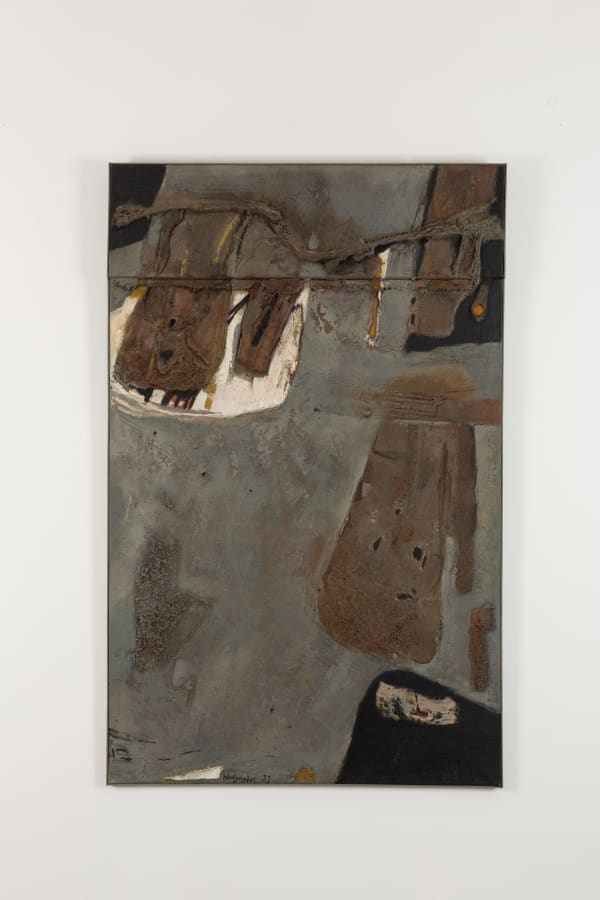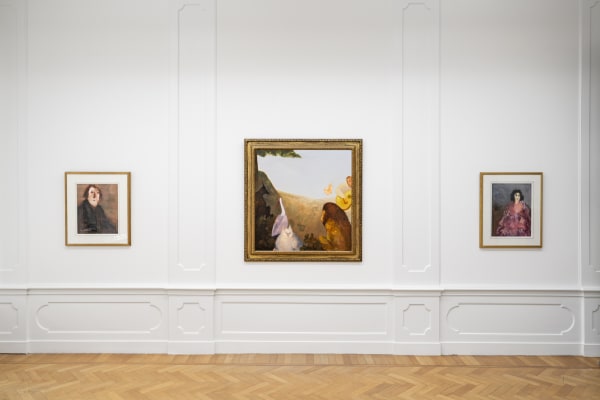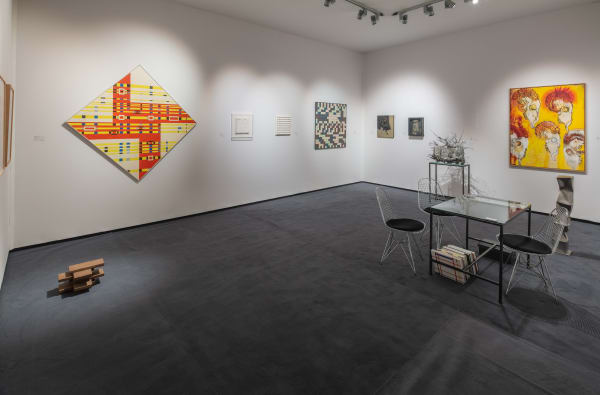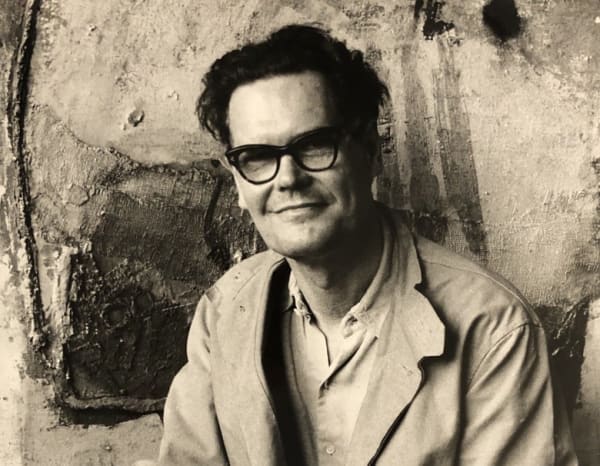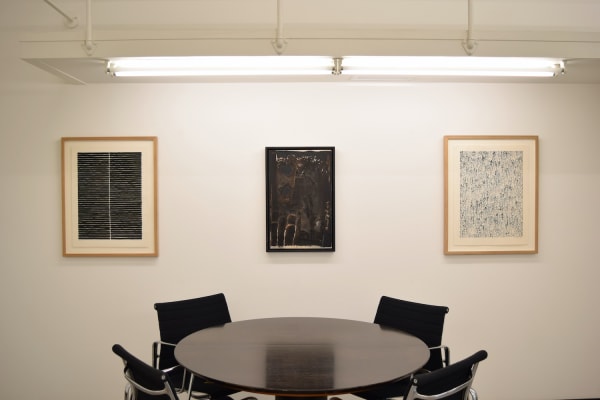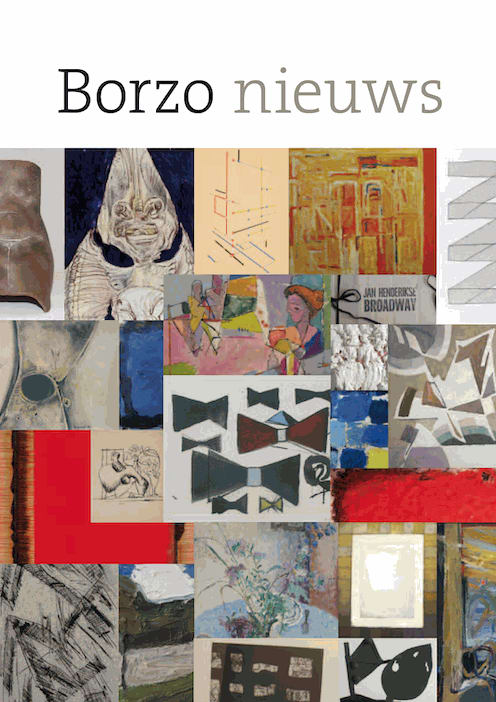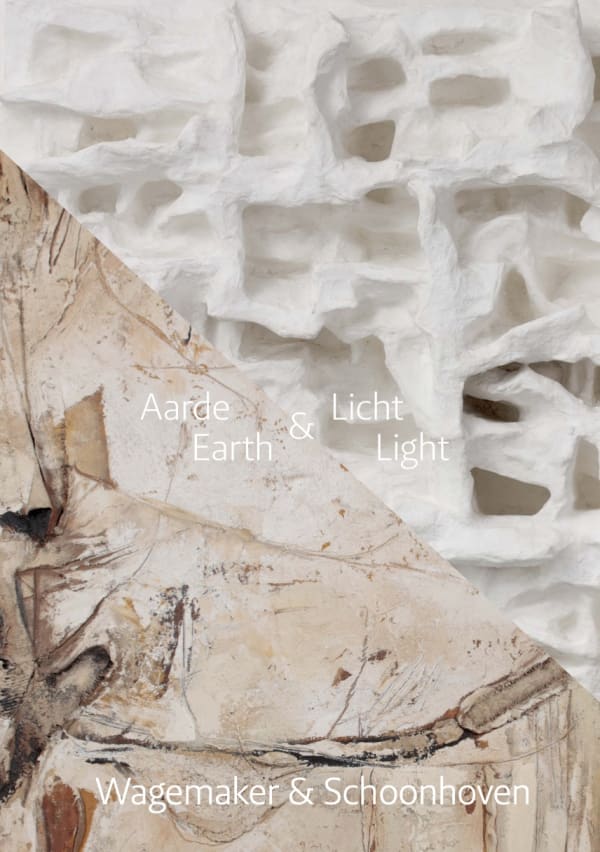Jaap Wagemaker Dutch, 1906-1972
Jaap Wagemaker is the Netherlands' foremost representative of the international movement known in the nineteen-fifties and sixties as Informal Art and more specifically by its technical classification: 'matter painting'. The origins of this movement lie in the artistic developments in Paris after 1945. A free art form originates here, a lyrical abstraction that expressly breaks away from pre-war realism. In the Netherlands the CoBrA group was part of this movement of artists painting in a lyrical-abstract manner.
In the nineteen-fifties an alternate movement emerged out of this free and often colourful abstraction, which became known as 'Informal Art'. Any semblance of recognisably figurative forms and elements disappear from the painting and the material, the matter, becomes a crucial means of expression for a small number of like-minded artists in Europe such as Alberto Burri in Italy, Antonio Tapiès in Spain, Emil Schuhmacher and Karl-Fred Dahmen in Germany, Jean Fautrier and Jean Dubuffet in France and Wim de Haan, Bram Bogart and Jaap Wagemaker in the Netherlands.
The young Wagemaker goes to the School for Architecture, Decorative Arts and Crafts in his hometown of Haarlem with the aim of becoming a decorator. Nonetheless, notably after visiting Paris several times as a young man in the nineteen-twenties and thirties, he decides to become a painter. He feels drawn to the expressionism of Constant Permeke and Herman Kruyder with his vigorous forms and earth colours. He continues to develop after the war and for a brief period the colourful idiom of CoBrA can be seen in his paintings. He spends some time in Paris in the studios on the Rue Santeuil, where his fellow Dutchmen Karel Appel, Corneille and Bram Bogart also live.
Wagemaker's first experiments with a freer, more robust use of materials dates from 1956, after which he rapidly establishes his reputation as a 'matter painter'. He finds fame in Germany in particular and Jaap Wagemaker exhibits in the major galleries. Museum Boymans van Beuningen in Rotterdam acquires the first of his works in 1956 and his debut exhibition in the Stedelijk Museum Amsterdam is in 1957. The Rotterdam gallery-owner Hans Sonnenberg was a significant ambassador for Wagemaker in the Netherlands. His exceptional eye for new and international developments means that it is Hans Sonnenberg who presents the Italian artist Manzoni in the Rotterdamse Kunstkring in 1959 and brings his revolutionary work together with that of Jan Schoonhoven and ….Jaap Wagemaker, among others.
In 1960 Jaap Wagemaker wins the 'Premio Marzotto' a famous Italian award of the time. The prize and exhibition contribute enormously to his international reputation. Wagemaker takes part in the exhibition 'The Art of Assemblage' in the New York Museum of Modern Art in 1961. In addition the MoMA buys one of his works. He is awarded the prestigious Talens Prize in the Netherlands in 1962. Major Dutch and international museums acquire his work. In 1962 he participates in the Venice Biennale. In 1965 he receives the "Association internationale des critiques d'art", the "Prix de la Critique" and in 1966 the inaugural 'Staatsprijs voor Beeldende, Kunsten en Architectuur'.
As an enthusiastic collector of ethnographic art and also as a traveller and photographer Jaap Wagemaker travels frequently to North Africa and the Near East. He emphatically and visibly processes the impressions from these trips and the inspiration from his ethnographic art collection in his matter paintings and assemblages.
Jaap Wagemaker dies prematurely and unexpectedly during a hip operation in 1972.
"We cannot take anything away from the earth; we can only change its shape".
It is this statement by Albert Einstein, once quoted by Wagemaker during an interview, which to a great extend formed the core of Wagemaker's artistry. Sand, fibres, slate, ashes, bones, metals, wood. Jaap Wagemaker did not add anything to the earth, nor did he take anything away from it. He only changed its shape. (from Jaap Wagemaker, schilder van het elementaire, S. den Heijer & van der Knaap, Zwolle 1995, p. 250)
-

The Nature of Nature
30 Oct - 22 Nov 2024Paintings by Paul Butti (1924 - 2004), Charles Popelier (*1955), Jaap Wagemaker (1906-1972) Photography by Jan Commandeur (1954-2024) In Paris, after 1945, a free art emerges-a lyrical abstraction that explicitly...Read more -

Recent acquisitions
20 Jan - 16 Feb 2024Borzo starts the new year with a group exhibition of recent acquisitions. In the front room a group of artists who have a relationship with each other both artistically and...Read more -

Frieze Masters 2023
Stand D12 11 - 15 Oct 2023Our presentation at the 2023 edition of Frieze Masters is a celebration of the centennial of Shinkichi Tajiri (b. 1923 Los Angeles, USA - d. 2009 Baarlo, The Netherlands) with...Read more -

Opening gallery season 22/23
2 Sep - 8 Oct 2022After the Corona years of cultural poverty, of temporary closures of museums, theaters and galleries, of cancellations and visitor restrictions, of do's and don'ts, it is a beneficial experience to...Read more -

TEFAF Maastricht 2022
Stand 449 25 - 30 Jun 2022After a long break, TEFAF Maastricht - and with it BorzoGallery - can meet the public in person again. We look forward to welcoming you to our stand, where we...Read more -

Art Affair. The Summer edition
Stand 8 17 - 20 Jun 2021TWELVE DUTCH ART DEALERS ENTER INTO AN ART AFFAIR FOR THE SECOND TIME The small-scale art fair Art Affair will take place for the second time in the ballrooms of...Read more -

The Drawing
1 Feb - 30 Apr 2021More than all other visual art forms, the drawing shows the most direct and most intimate insight into the soul of the artist. Drawing as a direct transfer from the...Read more -

TEFAF Online 2020
ONLINE ONLY 1 - 4 Nov 2020The first edition of TEFAF Online will take place from 1 to 4 November, where 300 international participants will each show one top work. You can register via www.tefaf.com ....Read more -

Earth & Light | Jaap Wagemaker & Jan Schoonhoven
3 Sep - 3 Oct 2020In 1959 Hans Sonnenberg organized the ZERO exhibition in the Rotterdamse Kunstkring, with work by Manzoni, Van Bohemen, Tajiri, Wagemaker and Schoonhoven among others. A year before this, Hans Sonnenberg,...Read more -

TEFAF Maastricht 2020
Stand 448 5 - 15 Mar 2020BorzoGallery is pleased to participate in TEFAF Maastricht in 2020. Just as in previous years, a striking stand is designed by the Amsterdam firm HOH Architecten . The larger of...Read more -

Jaap Wagemaker & Tribal Art
"Amsterdam Trail" 5 - 7 May 2017The Amsterdam Trail a route along galleries with ethnography and modern and contemporary art Amsterdam May 5 - 7 open all days from noon till 6 PM For the 6th...Read more





